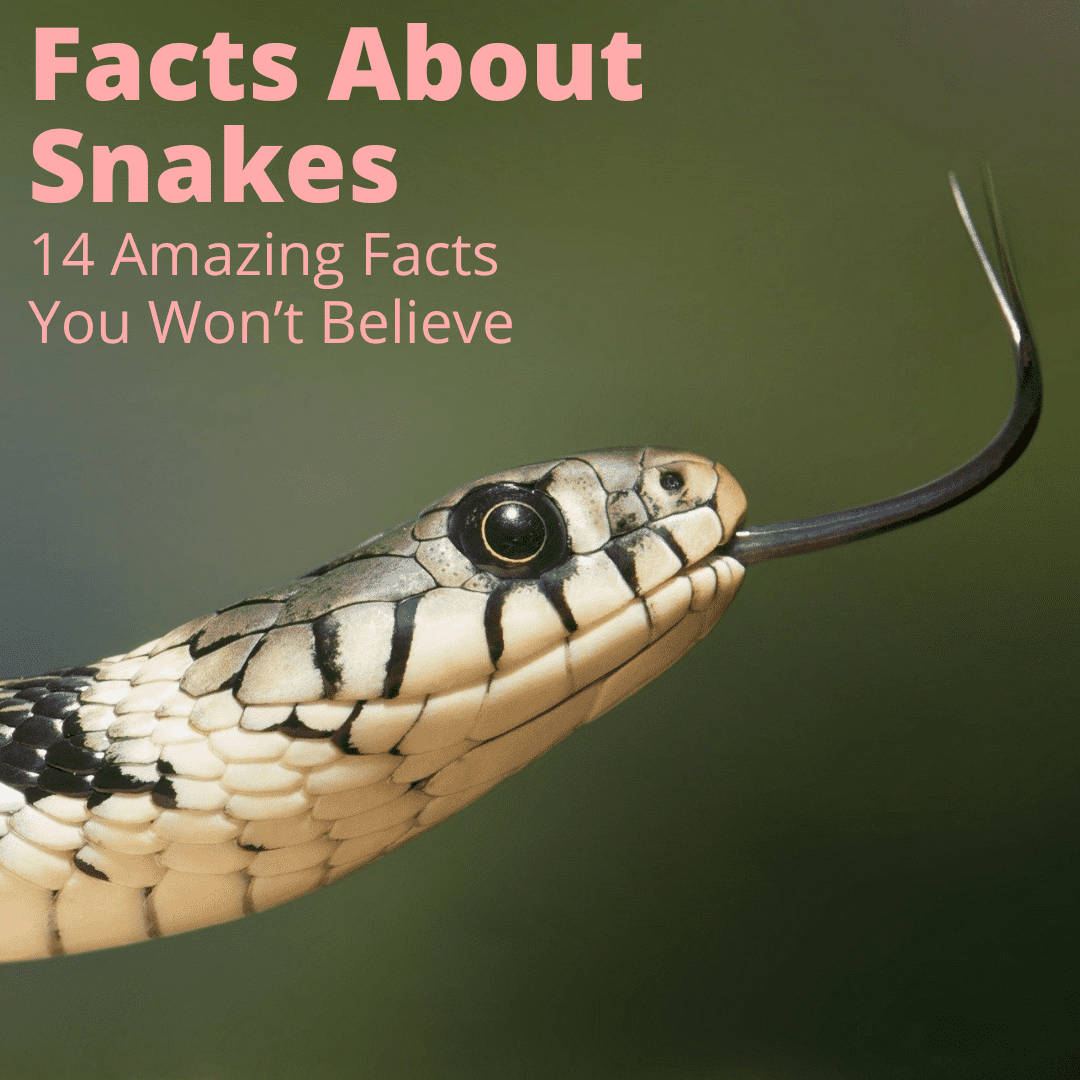
We humans have feared them, and been fascinated by them, throughout our entire history.
You’d think, then, that we know everything there is to know about these creatures.
But we don’t. In fact, there are an incredible number of facts about snakes we don’t know.
The 14 snake facts presented below are obviously not unknown, or we would not be able to tell you about them.
But they are not commonly known facts. And they are quite surprising. We’re sure you’ll be shocked by at least some of them.
Table of Contents
- 1 Facts About Snakes
- 1.1 Fact 1: Some Snakes Have Two Heads
- 1.2 Fact 2: The Number Of Vertebrae And Belly Scales Are Equal
- 1.3 Fact 3: Spitting Cobras Always Fire Bullseyes
- 1.4 Fact 4: Snakes Are Not Good Parents
- 1.5 Fact 5: Snakes Do Not Sense The Way We Sense
- 1.6 Fact 6: Some Snakes Can Reproduce Without Having Sex
- 1.7 Fact 7: Males Have Two Penises
- 1.8 Fact 8: Snake Venom May Help Prevent Stroke
- 1.9 Fact 9: Some Snakes Can “Fly”
- 1.10 Fact 10: Snakes Can Separate Their Jaws
- 1.11 Fact 11: Some Snakes Steal Venom From Toxic Toads
- 1.12 Fact 12: Snakes Used To Eat Baby Dinosaurs
- 1.13 Fact 13: Their Skin Is Made Of Scales
- 1.14 Fact 14: Snake Dreams Are Incredibly Common And Elightening
- 2 Facts You Need To Know Before Getting A Pet Snake
- 3 The Truth About Snakes
- 4 Snake Facts: Final Thoughts
Facts About Snakes
Snakes are one of the most feared creatures on our planet. They are also some of the strangest.
While we can easily debate the first (there is no need to fear snakes), we can’t argue the second. They are strange, but that just makes them even more fascinating.
Let’s take a look at 14 incredible facts about snakes you probably don’t know.
Fact 1: Some Snakes Have Two Heads
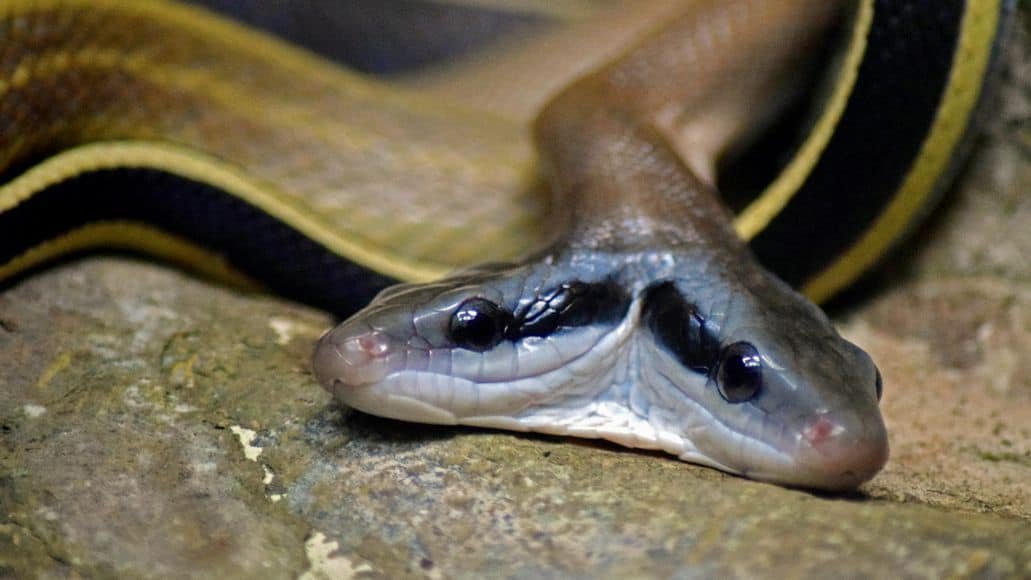
It is rare, but some unique snakes are born with two heads. Both heads have a brain and both brains control the body, which makes for some difficult times.
You can definitely tell that a two-headed snake is being controlled by two brains, because they move strangely, with each brain wanting to take the body in a different direction.
They also sometimes fight with each other. For example, they may fight over which head gets to eat some food, even though it is going to end up in the same body either way!
So how does a two-headed serpent come about?
It has to to with the embryos. Where usually, an embryo would split and each new embryo ends up forming a separate snake, sometimes an embryo does not split completely and a snake with two heads results.
When this happens in the wild, the snake does not live long. But they can live for several years in captivity.
Fact 2: The Number Of Vertebrae And Belly Scales Are Equal
You can find out how many vertebrae the snake has, by counting the number of belly scales. Each vertebra comes with a new scale.
Fact 3: Spitting Cobras Always Fire Bullseyes
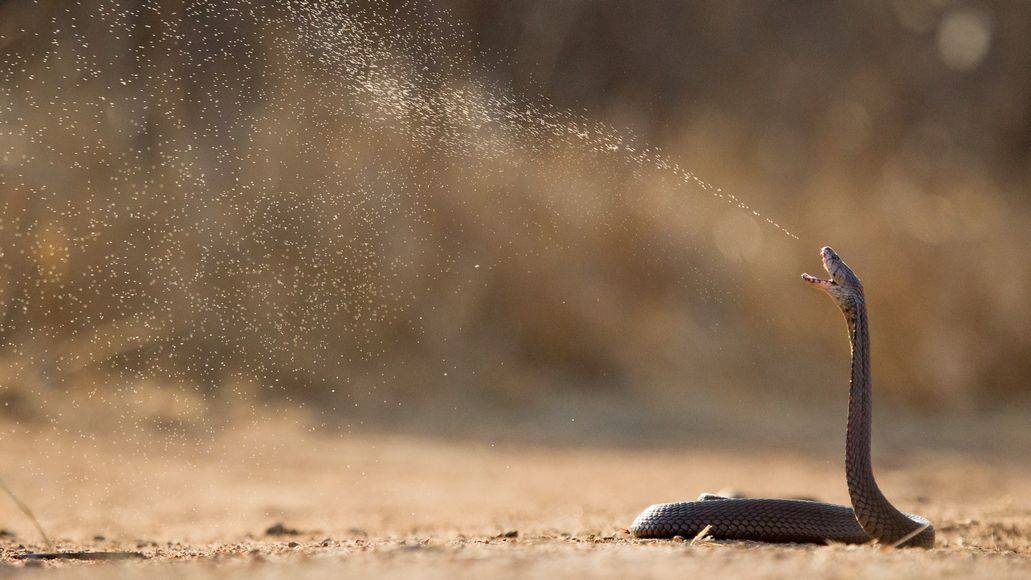
Spitting cobras have developed the ability to spray their venom for a distance of up to 6 feet, as a defense mechanism. Their venom blinds their victims, rendering them unable to continue an attack.
Obviously, in order to be effective, spitting cobras have to launch their venom directly into the eyes of their victims. And they do.
They can hit targets within two feet every single time. Seriously. They have 100% accuracy. But how do they achieve this deadly accuracy?
They wait. They track the movement of the victim and use that to determine where the eye will be next. Then they aim their venom ahead of their victim’s eye, at the spot where the eye will be when the spit venom arrives.
Not only that, but they also spray their venom in a complex pattern, to maximize their chances of nailing the eyes. Muscles in the cobra’s neck and head move the snake’s head rapidly, to produce these spraying patterns. The movements are so rapid that high speed photography and electromyography is needed to detect and map them.
If you’re wondering why the venom does not do anything to the cobra itself, read “Are Snakes Immune To Their Own Venom?” for much more on that.
Fact 4: Snakes Are Not Good Parents
When it comes to taking care of their children, snakes are definitely absentee parents. The fathers have nothing to do with their offspring, taking off right after copulation.
The mothers are slightly better. Some species lay eggs, while others have live young. Some of the egg-laying species incubate and protect the eggs after laying them, but others lay them and take off immediately after.
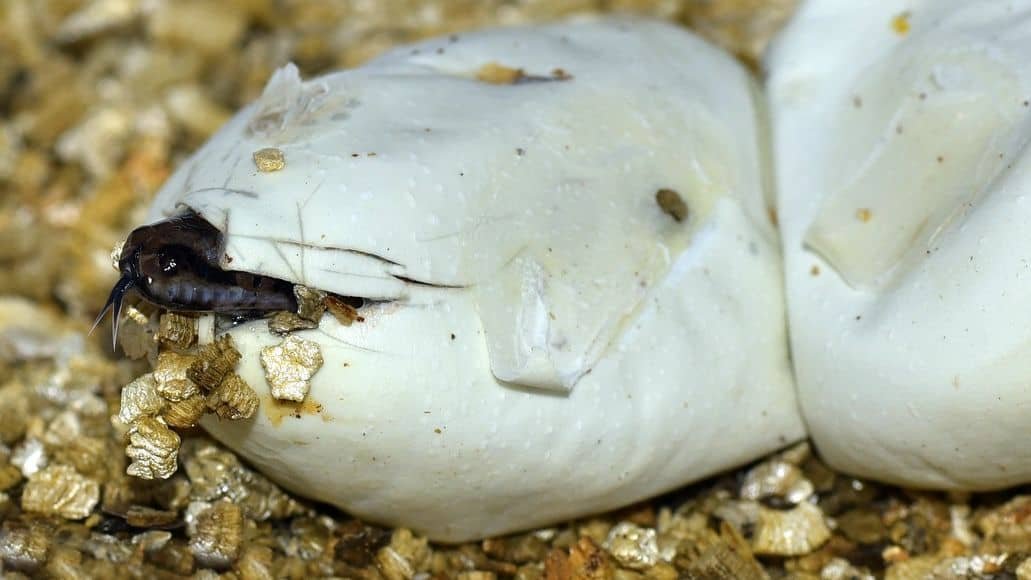
Once the babies hatch, or if they are born live, they are on their own immediately. They are already able to fend for themselves, but because they are small and vulnerable, many do not survive.
Fact 5: Snakes Do Not Sense The Way We Sense
We rely on our sight and our hearing. Most snakes are not great at either of those. They do not have ears, so they can’t hear anything but the lowest frequencies, which they actually sense, instead of hear.
When it comes to vision, there are large differences among species. Some see very clearly, while others only see shapes. But many snakes have other senses that make up for their lack of vision and hearing.
Vipers and boas, for instance, have heat sensing pits that allow snakes to detect heat signatures. They also use their tongues to pick up odor particles from the air and send them to their Jacobson organ, which analyzes them and provides info to the brain.
They also taste in this way. They may not have taste buds, but their tongue and Jacobson’s organ function together to perform the same task as taste buds would.
Fact 6: Some Snakes Can Reproduce Without Having Sex
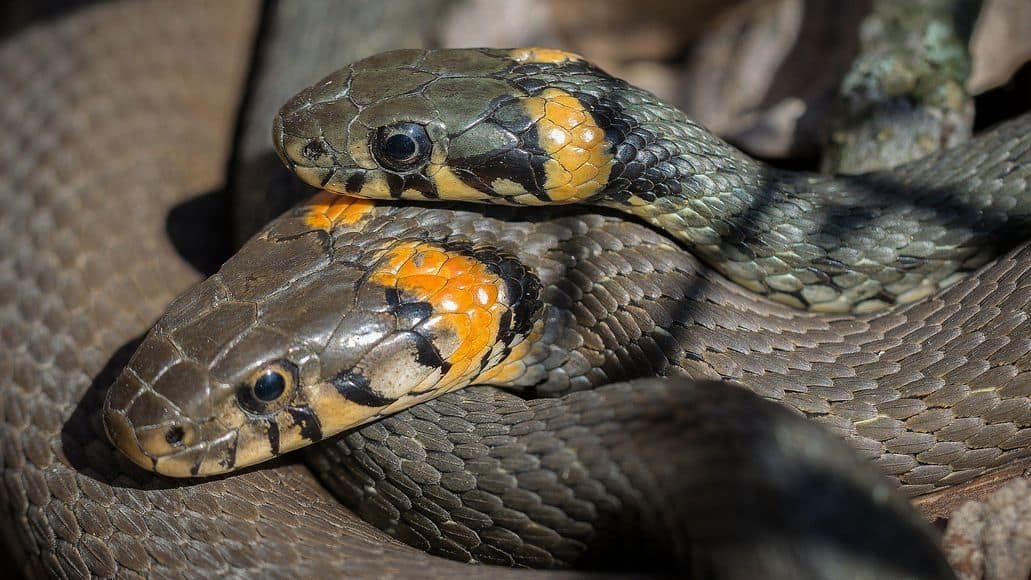
There have been multiple instances of snakes reproducing asexually. For example, North Carolina State University studied a female boa constrictor that has produced offspring both with, and without, male help.
When snakes reproduce without copulation, they do so through a form of asexual reproduction called parthenogenesis. This is where an egg develops into an embryo, despite never being fertilized.
Because babies produced in this manner are clones of the mother, they are all female and they have the exact same color mutation as their mother.
What is interesting is that the female in the study had the opportunity to mate with males, but reproduced asexually anyway. Generally, snakes only reproduce asexually if the option to reproduce sexually is not available.
Fact 7: Males Have Two Penises
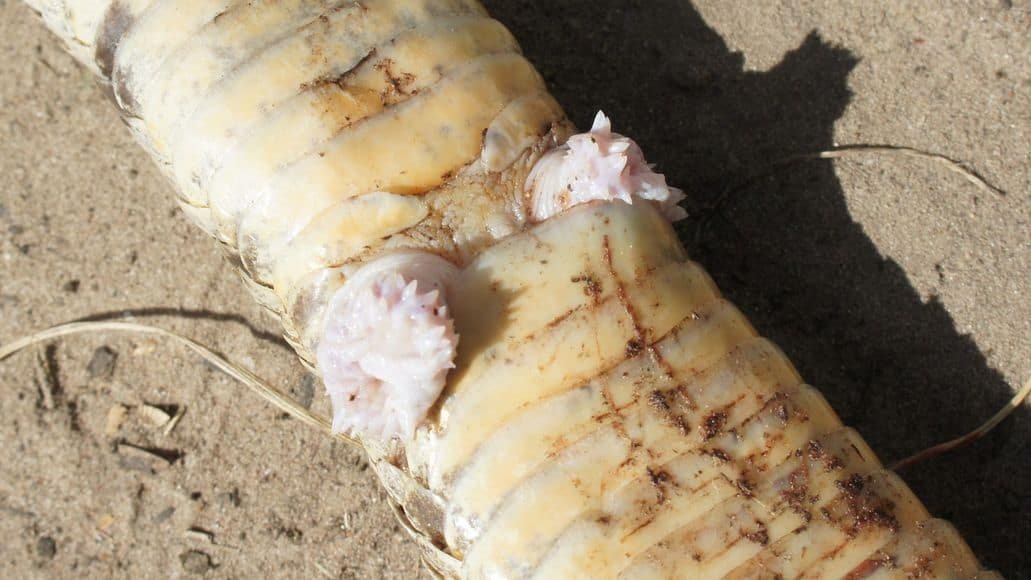
Male snakes have two reproductive organs, called hemipenes. Each penis is attached to a single testicle that supplies it with sperm.
Why do snakes have two hemipenes? To increase the chances of passing on their genetic material. During mating, the snake will only use one penis That way they can mate with a second female using their other penis in short succession.
The hemipenes of different species have different shapes. Many of them have scaly protuberances. What is cool is that the cloaca of the female of the same species has the exact shape and makeup to perfectly accommodate the male penis of its species. For that reason, snakes of different species can not procreate.
Fact 8: Snake Venom May Help Prevent Stroke
Many scientists believe that snake venom holds the key to curing numerous diseases. In addition to stroke, it also has the potential to lead to the development of treatments for heart disease or cancer.
The key are toxins in snake venom that can cause blood clots, and can also prevent them. They do so by targeting a receptor protein on blood platelets. The theory is that by inhibiting this receptor protein, we could stop the formation of irregular blood clots that lead to a stroke or a heart attack, and perhaps also stop the spread of cancer cells.
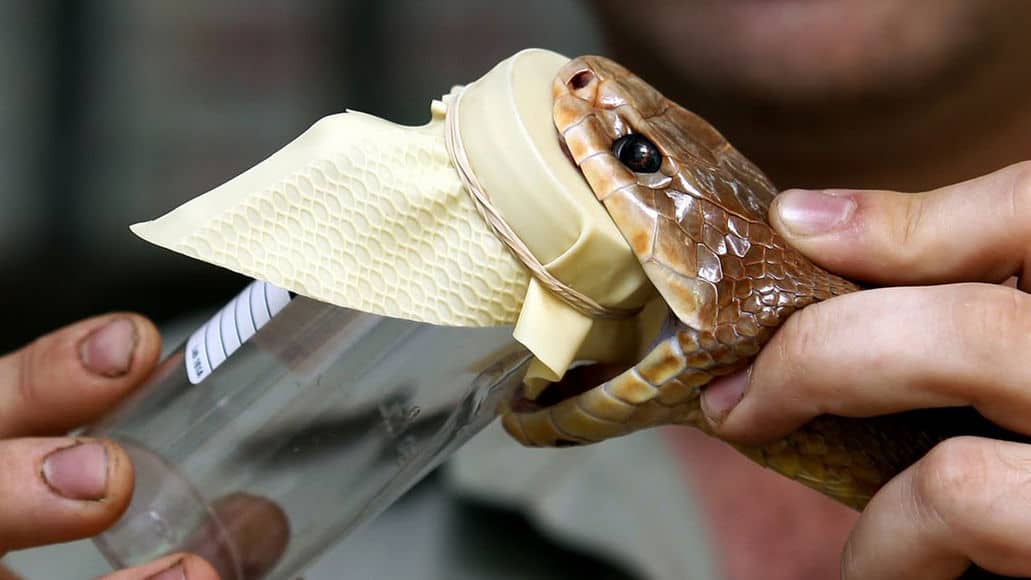
Blood clotting is a natural process. When blood vessels are damaged, blood can flow out freely. Blood clotting block up the damaged part of the vessel and stops the bleeding.
It is a process that saves our lives. But it can also kill us if it goes wrong. When platelet clotting goes wrong, it can cause strokes or heart attacks. The platelet protein CLEC-2 is responsible for blood clotting.
It is also used in the development of lymphatic vessels. Lymphatic vessels help to prevent swelling in tissues. They contain podoplanin, which is a molecule that binds to the CLEC-2 receptor on platelets. Snake venom does basically the same thing.
This podoplanin helps blood clots form and is also used by cancer cells to defend against our immune system. Researches believe that the interaction between podoplanin and CLEC-2 promotes cancer growth.
That is why snake venom is prized and harvested. Understanding its effect on our blood cells could lead to cures for some of our biggest killers.
Fact 9: Some Snakes Can “Fly”
Ok, so they can’t actually fly. But some snakes in Southeast and South Asia look like they can, by propelling themselves through they air with sufficient force to travel up to 24 meters. Check out this video to see them in action.
Scientists studying this phenomenon used video cameras to record the snakes “in flight” and create reconstructions to show the movement and position of their bodies.
These reconstructions showed that the snakes never actually glide, so they are not really flying. They simply push off with so much force that they actually launch upward. But eventually, gravity takes over and pulls them toward the ground.
In effect, they are just incredibly good jumpers, although they are not technically jumping either.
Do snakes jump at all?
No, they do not. But what these ‘flying’ or ‘jumping’ snakes do is still quite an amazing feat for an animal with no legs! They also move surprisingly fast for a creature without legs. Read “How Fast Can A Snake Slither?” for more.
Fact 10: Snakes Can Separate Their Jaws
In most animals, the bottom part of the jaw is locked in place, but snakes can actually separate their jaw into two parts. This allows them to open their mouth extremely wide, so that they can swallow their prey whole. I’m sure you’ve seen images or videos of snakes swallowing animals far larger than you’d think possible.
Fact 11: Some Snakes Steal Venom From Toxic Toads
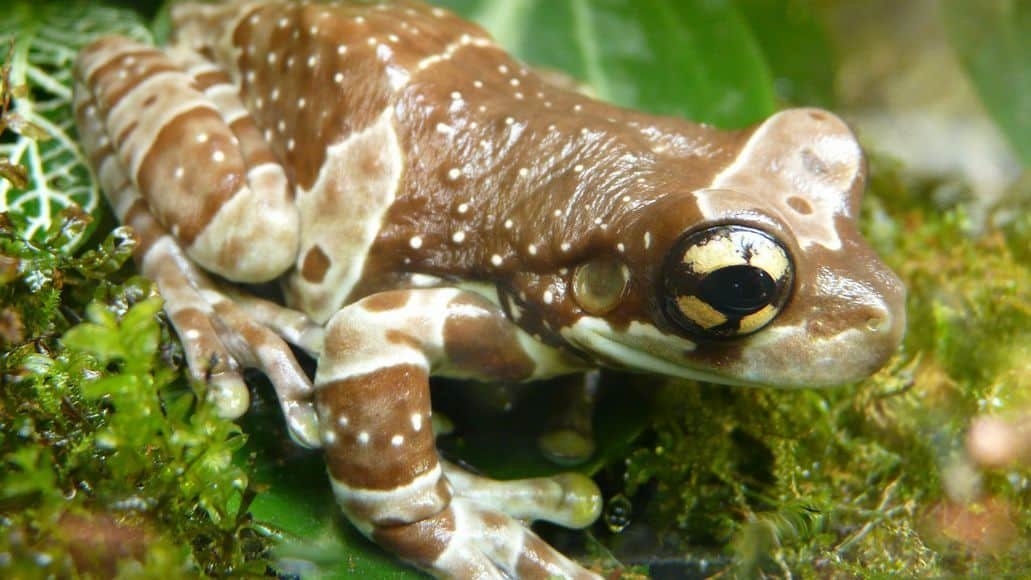
The tiger keelback snake (Rhabdophis tigrinus) of East Asia and Southeast Asia is non-venomous. But it has learned how to change that.
It eats toxic toads and store the toxins they get from those toads in two nuchal glands in their neck. When threatened, they can release these toxins as a defense mechanism.
Not only that, a pregnant female can also pass the toxins on to her babies. The young snakes use these toxins to protect themselves until they are large enough to hunt toads and supply themselves with toxins on their own.
Fact 12: Snakes Used To Eat Baby Dinosaurs
This fact probably shouldn’t be too surprising, but it is something I never thought about until I learned it. Snakes have existed since the time of the dinosaurs, so it only makes sense that they would have interacted.
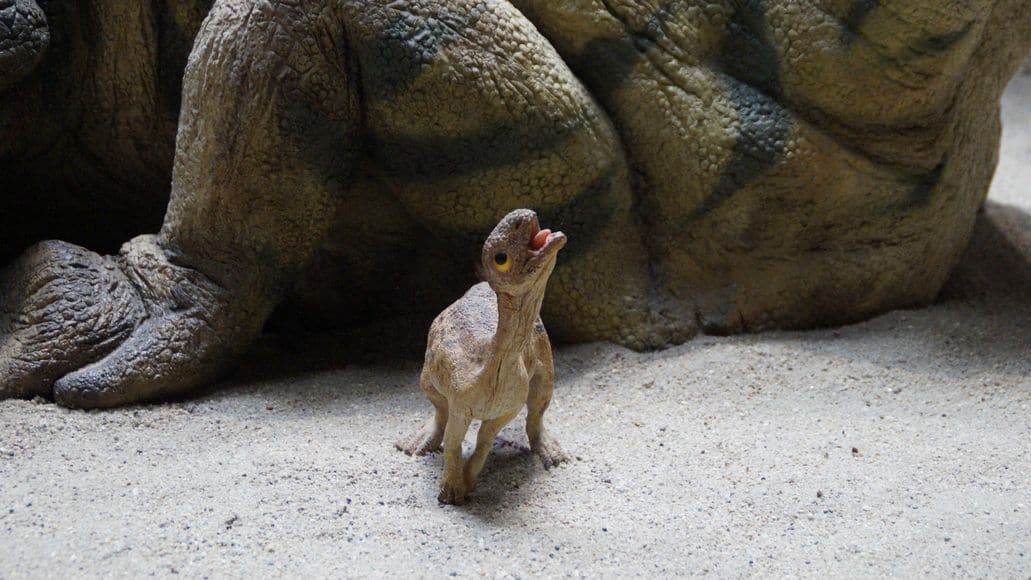
We know of this thanks to fossils discovered in India. Researchers found the fossilized remains of an eleven and a half foot primitive snake, Sanajeh indicus, inside a titanosaur nest. The snake’s body was wrapped around a crushed titanosaur egg near, the fossilized remains of a little hatchling.
This suggests that these snakes ate titanosaur hatchlings. They would have made great prey. When still inside the eggs, the snakes could not get at them.
And since the hatchlings grow very quickly and eventually reach an enormous size, this was really the only stage in their life where they made good snake food.
Fact 13: Their Skin Is Made Of Scales
Many people think snakes are slimy, but they actually aren’t. They are simply scaly, because their skin is made up of scales.
The scales help the snake move by gripping whatever surface it is on and pushing off to propel the animal forward. But the skin does not grow with the snake.
Instead, when the snake grows too large for the skin, a new skin grows underneath the old one and pushes the old skin cells up in a transparent layer. When the new skin is ready, the snake sheds the old skin. This happens in several phases.
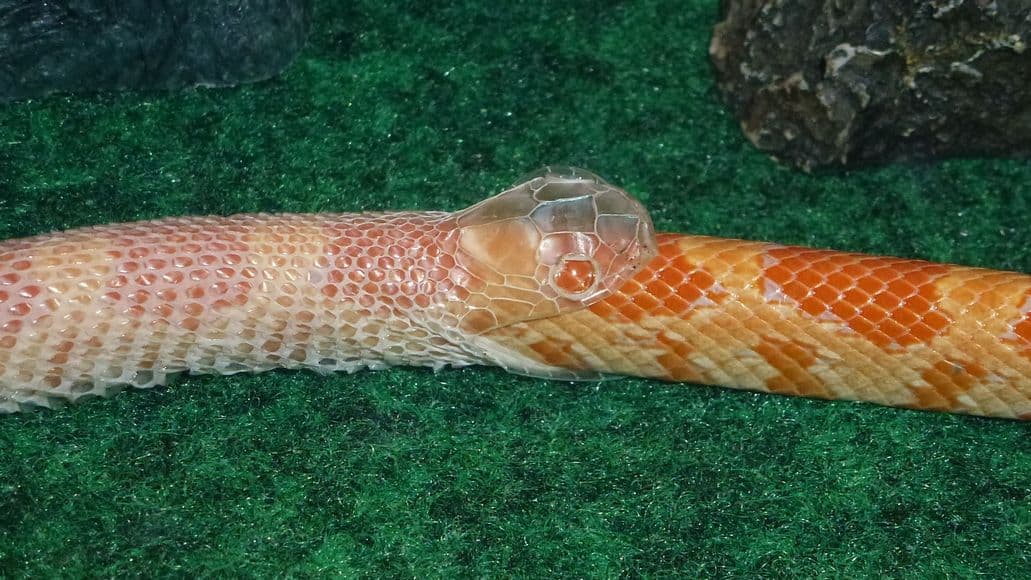
In the first phase, the skin starts to feel rougher and you will usually see a pinkish hue on the belly. In the second phase, the layer of skin covering the eyes starts to loosen. As a result, the eyes take on a blue color and the snake can’t see anything for a few days.
In the third phase, the snake goes back to looking completely normal. You probably would never guess it was shedding, if you missed the first two phases. But this phase actually means it is very close to actually loosing the old skin.
To begin the shedding, the snakes rubs its head against a rock or log or some other object, to create a rip int he skin and begin pushing it off its head. Then it slowly slips out of the skin. It comes off in one piece and inside out, similar to how we might peel off a sock.
Because snakes never stop growing, they never stop shedding. But growth does slow down, so they shed less often as full-grown adults. Younger snakes generally shed every month or two, while adult snakes only shed a few times per year.
Fact 14: Snake Dreams Are Incredibly Common And Elightening
It is quite common to dream about snakes. And most cultures ascribe various meanings to snake dreams. What does it mean when you dream of snakes?
The interpretation of snake dreams differs considerably from one culture to the next. It also differs depending on the type of snake and the situation in the dream.
Facts You Need To Know Before Getting A Pet Snake
Did these facts make you want to go out and get a pet snake?
Then there are a few things you need to know beforehand. We’ll give you a brief overview here, but you need to do complete research on the species you want to get, so that you know how to properly take care of it and also know exactly what to expect.
This article on pet snakes goes into more detail on what you need to know before getting a serpent as a pet, but here are are a few things you need to take care of, to ensure your pet snake will feel welcome with you.
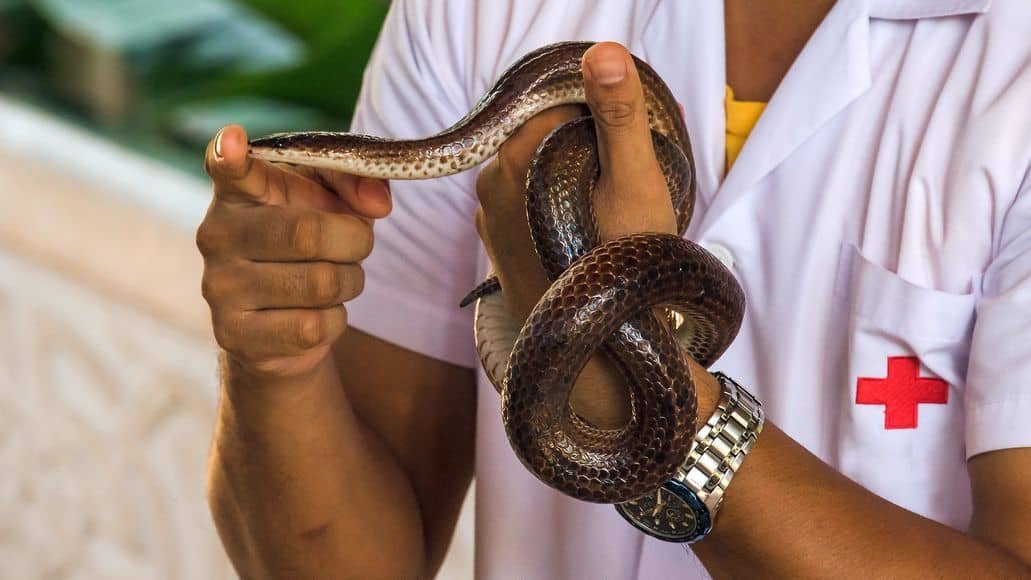
Enclosure
First of all, you need to think about an appropriate enclosure for your pet snake, so that it can move around freely and comfortably. This means it needs to provide plenty of space and not be too cramped. It also needs to have the same environmental conditions your snake species enjoys in the wild
The cage should be well ventilated so that your pet snake gets fresh air. you also need to maintain the temperature at the ideal setting. The cage should not only satisfy your snake but should also be easy and convenient for you to clean.
Snake enclosures can be made from wood, plastic, glass etc. You can also get large aquariums that work well for your pet snake. You will find a huge choice of them available to buy online.
Do your research to make sure you are buying a quality product for your pet snake. We have an article that covers the best enclosures for snakes.
You need to regularly clean the snake cage and change the bedding completely at least once a month. But you must remove and soiled substrate as soon as you notice it. If you leave it, the droppings pile up and can cause your snake to fall ill, and eventually die.
The type of substrate you need depends on the natural habitat of the snake. This will also determine the environment you need to create inside the enclosure.
Habitat
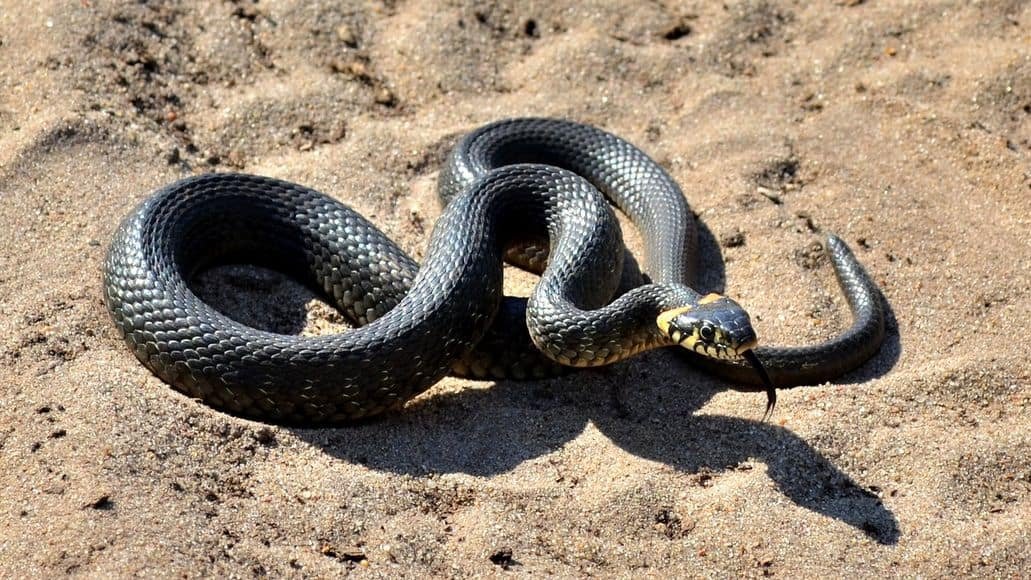
Snakes live in almost every climate, throughout the world. The only place they do not live are the Arctic regions. Since they are cold-blooded, they are not able to survive in such cold temperatures.
Apart from extreme cold, they are very adaptable. They live in deserts, cities, oceans, lakes, forests, mountains, savannas, rain forests etc. There are even snakes on the Tibetan plateau that use hot springs to keep warm.
asically, they live everywhere except the arctic, including areas that get quite cold in the winter. So how do they survive?
Enter brumation. This is like hibernation, but for cold-blooded creatures. Instead of shutting down everything and basically sleeping through the winter, they simply go into “low-energy mode.”
They stay awake and even move around, but they move very little and basically just rest until the weather gets warmer. They hide out an brumate in a warm, damp place, usually underground.
Diet
What snakes eat depends on their environment and their size. But one thing they all have in common is that they eat animals. Are there vegetarian snakes? No, though one species does eat eggs exclusively.
What do snakes eat? The most common foods are small mammals like mice, rats, rabbits, gerbils, etc., fish, eggs, lizards, and even other snakes.
The largest snakes can eat just about anything and have been known to prey on large animals like hippos or crocodiles.
Snakes are ambush hunters. They can lie in wait for days, until something passes by. Then they either bite it to inject venom or grab it and constrict it to squeeze it to death.
Once it is dead, they swallow the prey whole. As mentioned above, they can dislocate their lower jaw to open their mouth wide enough to swallow something larger than their mouths.
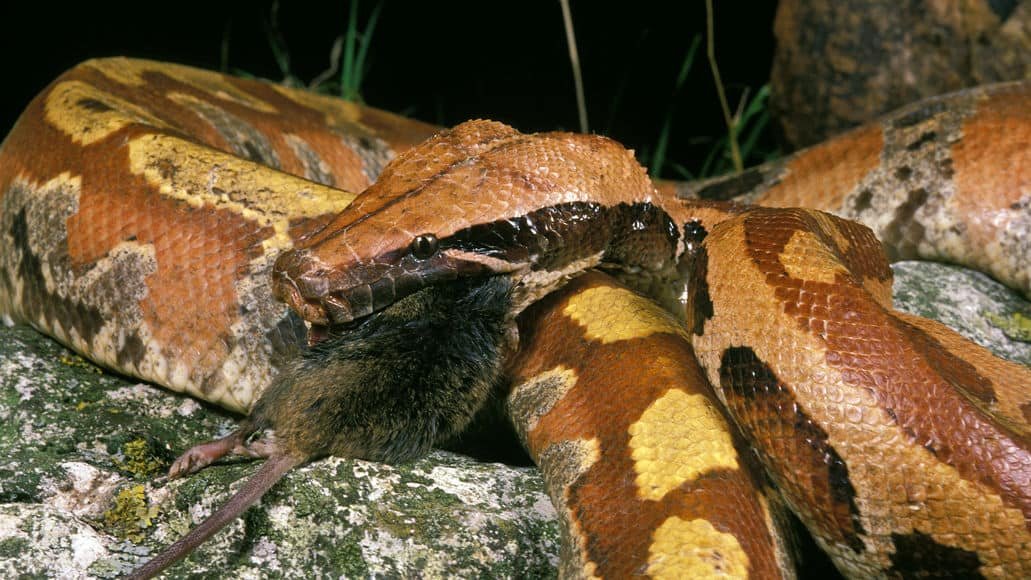
Most snakes have a hundred or more teeth that point toward the backs of their mouths. This makes it almost impossible for prey to get free once the snake has grabbed it in its jaw.
Because of the angle of the teeth, the only way to get off them is to move further back toward the snakes mouth, which only allows the snake to get an even stronger grip.
Once the animal has been swallowed, it is time for digestion. If you own a pet snake, it is vital to not disturb it during digestion. If it feels threatened in any way, it will regurgitate the food. Overall, digestion generally takes around 48 hours.
Regurgitation may not seem like a big problem, but it is. It turns the snake’s entire system inside out and if your snake regurgitates its food, you should wait at least 10 days before giving it more, to give it enough time to get back to normal.
The Truth About Snakes
Many people think of snakes as uniformly dangerous, while others think of them as exotic, interesting pets.
The truth is: most snakes are not dangerous, but some can be. You need to consider carefully whether you can handle having one as a pet.
Here are some facts about snakes to help you make your decision.
Snakes Are Not Easy To Care For
It is true that they require less maintenance than most pets, but they still need care and attention. Snakes need a reptile cage that is heated to the correct temperature. This means some form of heat lamp or mat and a thermostat.
Snakes are cold-blooded animals, so temperature control is extremely important for their health. They should also have an ultraviolet lamp.
In addition to their environmental needs, they have to be fed regularly using a hemostat. Snakes can be large, so you may need to use a snake hook to move them into their cage.
The cost of all of the supplies can add up, so think carefully about whether you can afford to take proper care of a snake.
Some snakes are also far easier to care for than others. Read corn snakes vs kingsnakes for a comparison of two breeds that are relatively easy to keep as pets, especially if you are a beginner.
Snakes Are 100% Carnivorous
Snakes do not eat anything other than small animals. You may have to feed them live mice, fish, or insects. In most cases, you can buy frozen varieties of these animals and thaw them out before feeding. If the idea of feeding your snake mic and rats bothers you, then snake ownership is not for you.
Snakes Are Prone To Mites
These vermin are a nuisance and can make your snake uncomfortable or unhealthy. You may need the help of your veterinarian to eliminate these pests. He or she will know how to get rid of snake mites.
Ideally, you want to take the proper measures to protect your snake from a mite infestation in the first place. The most important thing you can do is keep the enclosure clean.
Snake Facts: Final Thoughts
What did you think? Did you already know any of these facts about snakes, or were they news to you? If you didn’t know them, were you as amazed as we were to learn them?
Let us know in the comments below.
Rehan Razzaq says
Sir we are a good company that according to customer of that make of snake sticks for all types for example:
Animal Grabber Tongs, Standard Hook, Standard Snake Tong, Gentle Giant Tong etc.
we are registered by the chamber.
lf you interested contact us
l am waiting for you
Thanks & Regards
Interest Industry.
+923181769697